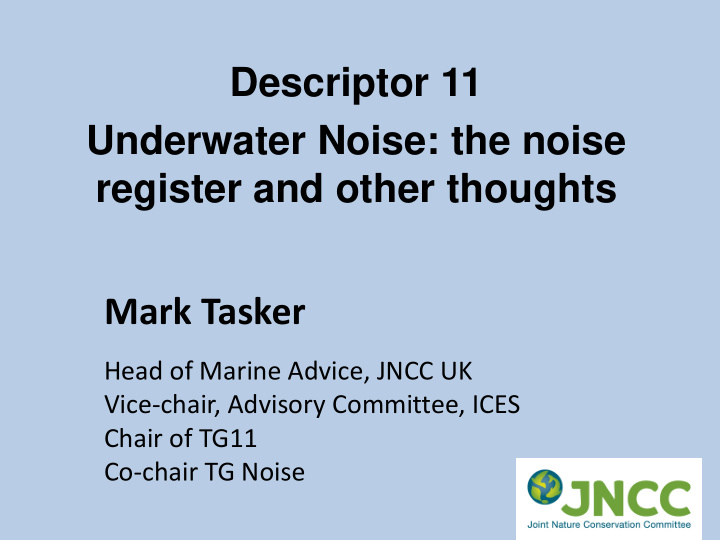



Descriptor 11 Underwater Noise: the noise register and other thoughts Mark Tasker Head of Marine Advice, JNCC UK Vice-chair, Advisory Committee, ICES Chair of TG11 Co-chair TG Noise
Introduction of energy, including underwater noise, is at levels that do not adversely affect the marine environment Descriptor 11
Harbour porpoises move away from pile driving during wind-farm installation Most cetaceans move away and change behaviour near active seismic vessels Fish respond to pile driving and seismic survey at short range Beaked whales strand (probably caused by behavioural change leading to the ‘bends’) near naval mid-frequency sonar Known effects
Two main “adverse effects” addressed Gaps in distribution caused by behavioural alterations after “loud” impulsive sounds Communication difficulties caused by low frequency noise
Commission decision: Proportion of days and their distribution within a calendar year over areas of a determined surface, as well as their spatial distribution, in which anthropogenic sound sources exceed levels that are likely to entail significant impact on marine animals measured as sound exposure level (in dB re 1µPa 2. s) or as peak sound pressure level (in dB re 1µPa peak ) at one metre, measured over the frequency band 10 Hz to 10 kHz .
The proportion of days within a calendar year, over areas of 15’N x 15’E/W in which anthropogenic sound sources exceed One (pulse) day likely to represent a series of pulses, “recovery time” also in order of days, not hours Area of effect for one species in order of 10s of km
either of two levels, 183 dB re 1µPa 2 .s (i.e. measured as Sound Exposure Level, SEL) or 224 dB re 1µPa peak (i.e. measured as peak sound pressure level) when extrapolated to one metre,
Why these source level recommendations? based on received levels for temporary threshold shift in small cetaceans in most comprehensive review of evidence available A better technical description might be to limit received levels at 1m to these figures Cannot guarantee no receiver near to source and adds precaution – e.g. for other receivers SEL and/or peak? Evidence that SEL matters more than peak in “damage”, not known for behaviour
measured over the frequency band 10 Hz to 10 kHz
High amplitude, low and mid frequency sounds – usually licensed or under EIA
Noise Register: Areas of 10 min lat and 12 min long chosen as these are UK licensing blocks for hydrocarbons; some information already exists on the basis of these (mostly seismic survey) – relatively easy to add other information. There are 3541 blocks or part blocks in UK marine waters.
UK PON14 for registering seismic surveys Map in wind farm Environmental Impact Assessment ? Other activities, e.g. explosives use, pile driving on coasts etc
Each block scored for a pulse day
MSFD Regional Sea North Sea Celtic Seas Total seismic pulse- 8502 7453 block-days in 2010 Number of UK blocks 1324 2216 in MSFD Regional Sea Average pulse days 6.4 3.4 per year per block Geographic variation in seismic pulse days by UK part of MSFD Regional Seas (2010 may not be typical)
Implications for implementation Needs a pre-licensing noise register for regulators to check against. Maybe easiest if some temporally-based targets set. The thresholds are merely a tool to register loud low frequency activities in the licensing blocks; no measurements are necessary, need to know which noises to register in advance. A larger management scale that was not possible previously in single EIAs; single EIAs only look at injury and not behavioural disruption.
How to manage? Multiple regulators in one country Multiple countries Shipping is international How do other industries share out common goods?
Fisheries Complex quota management that depends on many agreed rules (and which costs a great deal)
Carbon emissions Regional (e.g. EU) carbon markets where those emitting carbon buy and trade credits
Pesticides Fees levied on pesticide use – used to manage system and fund research
Offsetting Harbour porpoise bycatch in gillnets Several thousand likely killed in fisheries per year
For MSFD we need a management framework 1. Establish international noise register 2. International agreement on thresholds for concern 3. Model to determine if risk from disturbance infringes thresholds 4. Agree mechanism to share “noise allowance” internationally 5. Agree mechanisms to restrict amount of noise emitted NOT Simple!
Avoid noise – chose a different technology Reduce noise – use one of the noise reduction technologies Mitigate effect – e.g. turn off noise if animal arrives
Advertisement! Standards workshop BIAS Standards 8-9 April 2015 - What more are needed, BSH at least in interim before Hamburg ISO standards are developed Contact: Maria Boethling [Maria.Boethling@bsh.de ]

Recommend
More recommend